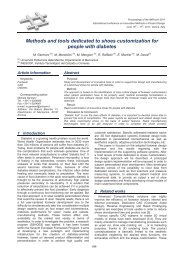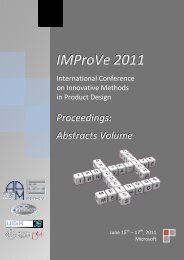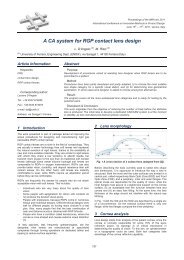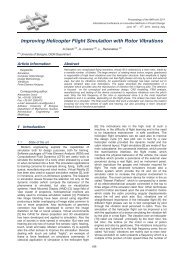IMProVe 2011 - Proceedings
IMProVe 2011 - Proceedings
IMProVe 2011 - Proceedings
Create successful ePaper yourself
Turn your PDF publications into a flip-book with our unique Google optimized e-Paper software.
Geometric Product Specification and Tolerancing<br />
An Extracting Points Strategy<br />
for Flatness Measurement on Components by means of CMM<br />
R. Rosa (a), S. Rizzuti (a)<br />
(a) Dept. of Mechanical Engineering, University of Calabria, Italy<br />
Abstract:<br />
The paper presents a semiautomatic procedure able to evaluate flatness error on real<br />
components by means of Coordinate Measuring Machine. The main problem in digital<br />
metrology is related to the dimension of the sample point size to be used in order to<br />
measure form errors with sufficient accuracy. The recent GPS rules establish a set of steps<br />
in which the measurement must be made. extraction is the step in which metrologists are<br />
urged to trade-off between small sample sizes (related to reduced costs and time) and<br />
accuracy (which should require a higher number of points).<br />
The best choice is to use the smallest sample size able to limit the uncertainty in<br />
measurements. These points should be extracted in the zones of maximum heights and<br />
valley.<br />
The paper discusses a procedure that has been tested introducing in the pre-analysis the<br />
qualitative methodology generally used for flatness evaluation by means of Prussian blue.<br />
This treatment shows the zones with peaks and valleys in a quick and easy way and the<br />
Metrologist is therefore able to extract points from these selected areas.<br />
The paper presents the results obtained about the flatness measurement on a matrix for<br />
injection moulding.<br />
Keywords: Flatness, measurement, GPS, CMM, Point extraction, Prussian blue<br />
Corresponding Author: Raffaele Rosa<br />
Tel.:+390984494601<br />
e-mail: r.rosa@unical.it<br />
Address:Cubo 45 C, via Pietro Bucci, Arcavacata di Rende (CS) Italy.<br />
Integration of tolerances in the mechanical product process<br />
M. Tlija (a), B. Louhichi (a), A. Benamara (a)<br />
(a) Laboratoire de Génie Mécanique LGM, École Nationale d’Ingénieurs de Monastir.<br />
Abstract:<br />
In the design process, minimizing differences between the numerical model and the<br />
manufactured product is the subject of several researches. It guarantees a better<br />
optimization of the mechanical product. Tolerance is one of the most used tools in the<br />
design model to illustrate functional requirements of mechanical systems. However,<br />
June 15 th – 17 th , <strong>2011</strong>, Venice, Italy<br />
91<br />
<strong>IMProVe</strong> <strong>2011</strong> - <strong>Proceedings</strong>










